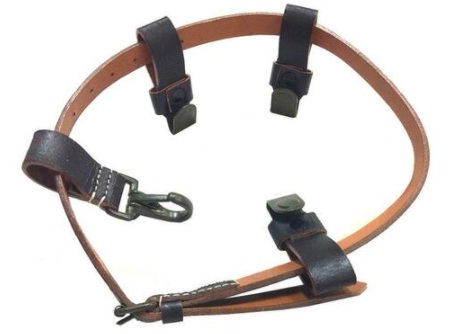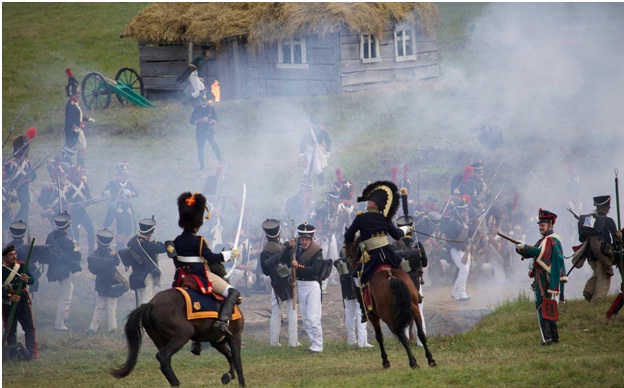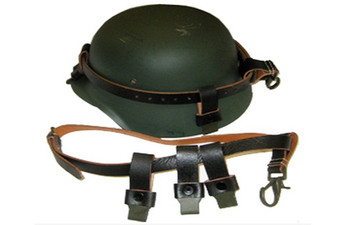What to Look for in a WW2 German Helmet Along with Some Cool Practical Uses
Mar 24th 2021
The German M35 Stahlhelm (“steel helmet”) is one of the most iconic battle helmets that has ever been produced. It ranks alongside the American M1, the French Adrian Helmet, and the immediately identifiable Pickelhaube in terms of impression produced and recognizability.
Speaking of the Pickelhaube, the Stahlhelm was actually produced to replace it. The Pickelhaube, with its imperious and imposing spoke, was typically made of formed leather. The growing demands of the battlefield quickly exposed the shortcomings of traditional leather helmets. Something made from steel was required, and the Central Powers weren’t the only ones to recognize it.
They were, however, the ones that produced the original Stahlhelms that evolved into the M35 WW2 German Helmet that has been widely featured in film and propaganda. Although the original design was developed in the First World War and featured several improvements in the coming years, the M35, named after the year 1935 in which it was developed, went on to become the design that is probably most widely known.
With thicker, stronger, more impact resistant steel and a smoother, rolled edge, the newer WW2 German helmet was tougher and provided better protection while providing more comfort as well. It can be said with confidence that the silhouette alone is recognizable. It is one of the most influential models that has ever been produced.
But enough of the prologue; you’re probably here looking for a WW2 helmet like this, and not for the history lesson. If you are here for the history lesson, check out our recent blog on the History of the Stahlhelm.
For those of you here with mercenary interests - including those of you looking for other historically significant helmets - here are some things to be on the lookout for. They’ll help you get the most value for your money.
1.Authenticity: Authentic or reproduction
The first and probably the most important thing you can consider when you’re weighing the purchase of a WW2 German helmet, or another helmet from World War II or any other period in history, is whether or not it is authentic and original.
Original, authentic helmets have histories that can be verified by the seller, indicating the year they were produced, in which country, and for which force. Here at Sarco, Inc., we have a number of authentic historic helmets from all around the world. You can see some of these in our collection of helmets.
Authentic helmets tend to cost a lot more money and, since one cannot simply make more of them they are commensurately more rare as well. They are highly sought by collectors and competition among purchasers has the potential to be particularly fierce. Once all of a certain model has been sold out by a vendor, it’s more a matter of “if” that seller will ever come by more” than “when.”
In contrast to authentic combat helmets you have reproductions, which, when they are fastidiously and meticulously produced, are effectively indistinguishable from the originals. However, since they are not original, they tend to command a lower price (though some are still expensive.) Additionally, since more can be produced, they are not as exclusive.
2.Authentic: Signs of use and wear
The value of an authentic helmet is built right in, because there are only so many of them and if you want one you need to be particularly careful of paying attention to availability. Once they’re gone, they’re gone. 1943 is not going to be coming around again anytime soon.
If the helmet is authentic, it’s going to be pretty old and there’s even a chance that it actually saw combat. Some originals are surplus, but others will show signs of wear and use. In that case, you can look at the condition of the helmet and the liner. Is the liner even present? Are there signs of dry rot? Is it original?
As for the steel pot, or the shell of the helmet, you can look for scrapes, dings, holes, dents or other blemishes, as well as signs of being repainted or touched up. Depending on the circumstances surrounding the purchase, these things could add or subtract value, so you should be sensitive to them.
3.Reproduction: Accuracy in reproduced elements
Some reproductions are excellently made and are nearly identical to the originals. One thing that will engender value in a reproduction is the level of authenticity it exhibits; that is, how closely and how faithfully it has recreated the elements of the original.
Even if the helmet in question is a reproduction and not an original, you should still pay attention to the relative details associated with the helmet or the piece of equipment in question. For example, a reproduction helmet can be specifically produced to recreate all of the features of the original helmet, and come with all of the necessary parts, including the helmet shell and liner.
Other things, for example, that you could look for include the number of ventilation holes as well as their orientation, the dimensions as well as the weight of the helmet, the thickness and composition of the steel uses, and other fine points. For example, for an M35 helmet, does the reproduction have the rolled steel edge and has it been finished with the Feldgrau, or Field Grey paint that was commonly used on originals? These points will naturally vary according to the product in question; when in doubt, ask!
4.Reproduction: Objective quality
There are other attributes that will provide or detract from the value of a reproduction helmet in addition to how closely it appears to resemble the original on which it is modeled. For example, consider that the dimensions, color and appearance of a reproduction could be completely indistinguishable, visually, from an original, while overall it is not a faithful representation.
By this we mean a WWII German helmet like an M35 Stahlhelm might be a perfect visual facsimile of the original without making use of the right thickness of steel plate. That would make the reproduction faithful in some aspects but not in others.
Then again, there are other things that could impact the quality of a reproduction helmet, such as whether or not the liner and straps were made out of real leather, or some synthetic material that saved money. Keep all of that in mind if you’re willing to buy a reproduction; not all are created equal.
5.Reproduction: What accessories does it come with?
Many reproduction helmets may just come with the steel pot and will lack the liner. Some helmets come with both and even have additional accessories, like a mesh net that some originals had. In some cases this is a mark of authenticity, in others it is just a nice little accessory that increases the value, appeal and functionality of the reproduction.

6.Reproduction: What additional value-added features does it have?
Finally, look out for other value-added features that any given helmet might contain. Some of these might increase the value or appeal of the helmet even if they weren’t strictly necessary to qualify the helmet in question as expressly faithful to the original.
For example, some helmets come with insignia corresponding to real ranks or identifiers of the troops that would have worn them. These are not the types of things you need to weigh in your decision, but they can increase the value and improve the appeal of the helmet you end up buying, so get into the fine print before you pull the trigger!
Uses for a WW2 German Helmet (or Any Other!)
Whether you eventually end up buying an authentic helmet from WW2 or you end up getting a reproduction of the M1 of the United States, know this: practical uses for it go far beyond display.
Honestly, display is a great use of a WW2 helmet, be it reproduction or authentic, but it is not the only one. If you need to justify the expense to yourself, consider some of the following interesting uses for original and reproduction helmets from all over the world and throughout history.
1.Increasing the value of a collection
The first and possibly the most important value that can be engendered with a reproduction helmet, or an original, is that it will increase the value of a collection significantly.
Do you collect militaria and other historical curios from some point in history, such as WW2? If you do, and your collection is themed, even a reproduction helmet has the potential to significantly impact its value in a positive way.
Original helmets are even significantly more valuable. If a reproduction adds value, just think of what an original can do. There’s just one thing to keep in mind here; originals should be protected from wear and tear and handled gingerly.
2.Connecting with history or setting the atmosphere of a place
Reproduction and original helmets can also be used to great effect to alter the spirit of a place. Even if you don’t have a dedicated display or collection, using a helmet or some other collectible as a component of decor or to enhance the setting is very effective. It’s the kind of thing that you have to try to experience, and you can get creative with it.
3.Paperweights and other curious uses
In this respect, you don’t have to have a dedicated use for a WW2 helmet, be it reproduction or authentic. They can be widely used to great effect to create a distinguished setting because of the gravity and impression they produce on a setting.
Add one to your desk as a memento of the past or use it as a paperweight. It will certainly add a lot of character of its own. That’s for sure.
4.Use in amateur filming
This is a bit of a fringe use, and we would restrict the practical or active use of any WW2 helmets to reproductions only, but this is a good use nonetheless. If you or someone you know is into amateur filming, then a reproduction helmet can be used effectively as a prop or as a part of a costume.
It’s definitely a rare use, but reproductions are great for it. Just don’t use original pieces for the same things; they’re far too rare and valuable.
5.Use in reenactments (or, where permitted, in MilSim or airsoft matches)
For those of you that are into reenactments or airsoft, a reproduction helmet can be an extremely useful, and a very cool, piece of equipment. Some reenactments specify the equipment with which you need to be prepared, which makes reproductions, helmets and otherwise, valuable pieces of equipment.

Additionally, MilSim airsoft matches, which require you to make use of very specific equipment and disbar the use of others, are a great place for accurate reproductions. Just be sure you’re allowed to carry the gear (including the helmets) that you intend to carry. The event may not allow certain equipment and may require others. You might be required to carry facsimiles of the equipment carried by American or German troops, for example.
6.Remembering the importance of the past
Finally, a good general use of WW2 German helmets and other historically accurate equipment is to remember the importance that the past has had in shaping the present. They say that those who forget the past are condemned to repeat it, and that’s true enough. A memento and a reminder of things past is a valuable attribute in any setting.
Give Us a Call!
Looking for a specific reproduction helmet, or even an original? We carry a wide range of helmets, including those modeled after German, English, American, Italian and Japanese originals.
We also carry a wide range of helmets from various other times throughout the course of human history, through the European Middle Ages all the way back to the ancient world.
If you’re looking for something specific, you have quite a good chance to find it here; you just need to get in touch with us. Give us a call at 610-250-3960 and we’ll help you find what you’re looking for, even if you don’t know where to start!

